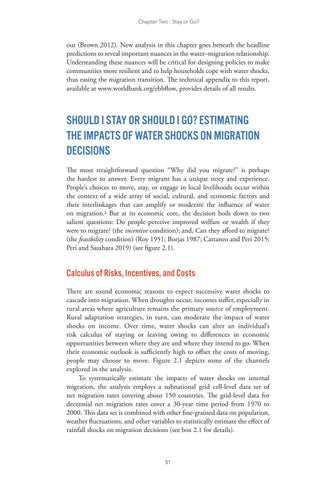Chapter Two : Stay or Go?
out (Brown 2012). New analysis in this chapter goes beneath the headline predictions to reveal important nuances in the water–migration relationship. Understanding these nuances will be critical for designing policies to make communities more resilient and to help households cope with water shocks, thus easing the migration transition. The technical appendix to this report, available at www.worldbank.org/ebbflow, provides details of all results.
SHOULD I STAY OR SHOULD I GO? ESTIMATING THE IMPACTS OF WATER SHOCKS ON MIGRATION DECISIONS The most straightforward question “Why did you migrate?” is perhaps the hardest to answer. Every migrant has a unique story and experience. People’s choices to move, stay, or engage in local livelihoods occur within the context of a wide array of social, cultural, and economic factors and their interlinkages that can amplify or moderate the influence of water on migration.1 But at its economic core, the decision boils down to two salient questions: Do people perceive improved welfare or wealth if they were to migrate? (the incentive condition); and, Can they afford to migrate? (the feasibility condition) (Roy 1951; Borjas 1987; Cattaneo and Peri 2015; Peri and Sasahara 2019) (see figure 2.1).
Calculus of Risks, Incentives, and Costs There are sound economic reasons to expect successive water shocks to cascade into migration. When droughts occur, incomes suffer, especially in rural areas where agriculture remains the primary source of employment. Rural adaptation strategies, in turn, can moderate the impact of water shocks on income. Over time, water shocks can alter an individual’s risk calculus of staying or leaving owing to differences in economic opportunities between where they are and where they intend to go. When their economic outlook is sufficiently high to offset the costs of moving, people may choose to move. Figure 2.1 depicts some of the channels explored in the analysis. To systematically estimate the impacts of water shocks on internal migration, the analysis employs a subnational grid cell-level data set of net migration rates covering about 150 countries. The grid-level data for decennial net migration rates cover a 30-year time period from 1970 to 2000. This data set is combined with other fine-grained data on population, weather fluctuations, and other variables to statistically estimate the effect of rainfall shocks on migration decisions (see box 2.1 for details).
51



